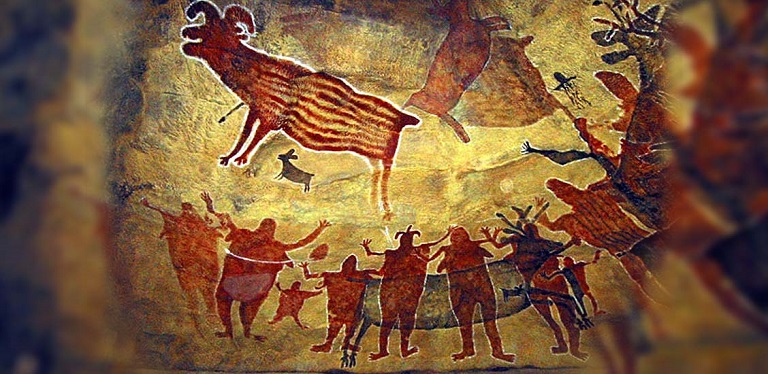Left with nothing, the five Pandavas, who were brothers, spent their exile living in a forest. Legend states that the Bhimbetka Rock Shelters were one of the places they stayed at. Bhimbetka itself means the place where Bhima, the strongest (physical strength) of the five brothers, sat.
 While the legend hasn't been proven, the caves and paintings at Bhimbetka hold proof that they have been inhabited since the Lower Paleolithic period. That is more than 200,000 years ago!
While the legend hasn't been proven, the caves and paintings at Bhimbetka hold proof that they have been inhabited since the Lower Paleolithic period. That is more than 200,000 years ago!Bhimbetka Rock Shelters were first discovered by accident in 1957 when an archeologist named Dr. V.S. Wakankar stumbled upon them. Located 45km from the capital of Madhya Pradesh, Bhopal, the natural sandstone rock shelters was declared as a UNESCO World Heritage site in 2003.
Surrounded by the dense forest of the Vindhyan Mountains, Bhimbetka is considered the largest depository of Stone Age art in India. Out of 760 rock shelters discovered, at least 500 have paintings displaying 'local birds and animals, mythological figures, and everyday scenes of people hunting, playing, and carrying weapons such as swords, spears, and bows-and-arrows'.
 However, not all the paintings are from the same period. One of the iconic artworks in the cave called 'Zoo Rock' has paintings of various animals ranging from the Mesolithic to Medieval periods. Colours like white, red, green, and yellow have been used in the rock paintings and they are believed to be at least 1000 (Indian Medieval Era) to 30,000 (Upper Paleolithic Period) years old. The paintings have gotten more complex with time. Apparently, specific elements like movement, perspective, and identifiable religious symbols can be seen in the later paintings.
However, not all the paintings are from the same period. One of the iconic artworks in the cave called 'Zoo Rock' has paintings of various animals ranging from the Mesolithic to Medieval periods. Colours like white, red, green, and yellow have been used in the rock paintings and they are believed to be at least 1000 (Indian Medieval Era) to 30,000 (Upper Paleolithic Period) years old. The paintings have gotten more complex with time. Apparently, specific elements like movement, perspective, and identifiable religious symbols can be seen in the later paintings.The rock shelters are a rare glimpse into the hunter-gatherer and how they interacted with each other and their surroundings. For those who are interested in visiting the rock shelters, only a small part of the complex is open to the public. Make sure to do your research before going there!
 Source: Atlas Obscura, Britannica, Soul Veda & Unesco
Source: Atlas Obscura, Britannica, Soul Veda & UnescoPhoto Credit: Pinterest, Awaaz Nation, Jagran Josh & The History Hub
